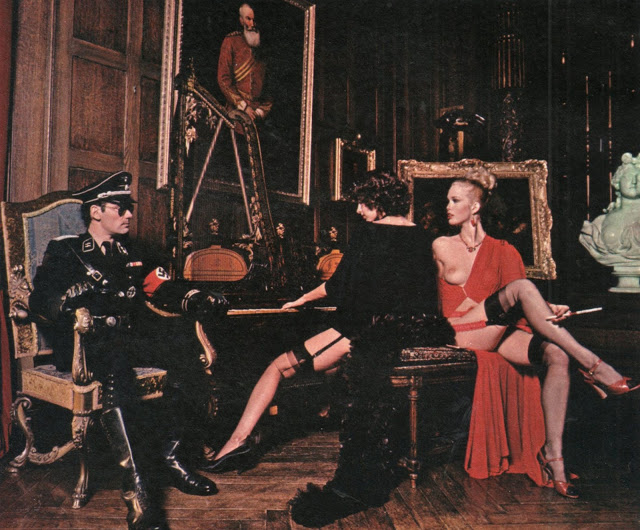Moore, Alison M. 2016 Sexual Myths of Modernity: Sadism, Masochism, and Historical Teleology.Lanham : Lexington Books
Myths take on a life of their own, even if they don’t have any particular foundation. One of them is the idea that the violence of fascism and the Holocaust was the result of sadomasochism, or that the two phenomena have anything to do with each other. We’ve touched on the bit of glib folk-anthropology that Nazis were perverts before, but Moore analyzes more thoroughly than anybody else.
The sexual myths of modernity this book aims to unravel are those which concern masochism as a from of decadent gender subversion, sadism as a fascist return of the barbaric repressed, and current sadomasochism as a legacy of Nazism. They are myths in the sense that their proliferation has been built on poetic assertion, psychoanalytic speculation, and discursive repetition, rather than investigation, reflection or evidential grounding. [Pg.1]
Although no historians have ever attempted to produce creditable evidence that Nazi leaders were any more prone to what we might call sadomasochistic pleasures than any other political elite has been as wartime, this particular sexual myth has show surprising recurrence, persistence and capacity for re-articulation. Consequently, it has also proven to be fuel for a range of taboo sexual fantasies[….] [Pg.9-10]
Moore traces out the genealogy (in the Foucaultian sense) of this idea. The root is Krafft-Ebing, coiner of “masochism” and popularizer of “sadism”. The author asks how he conflated vicious murderers like the medieval Gilles de Rais, outrageous pornographers like and harmless sexual play-actors under the same neologism. This continues even into the present day, when academics still succumbing to “historiographic tendencies to conflate genocidal cruelty with sadistic sexual desire and excess.”[Pg.9] She takes a social constructivist position by claiming that, while homosexuality had a cultural existence prior to the coining of the term, sadism and masochism didn’t.
For homosexuality, medicalization thus worked to define an object that existed in some form in social consciousness already. The same cannot so clearly be assumed about sadism and masochism. There was no popularly conceived pathology, perversion, or system of desire imagined in these terms prior to the invention of the medical categories that named these objects. Sade was understood in his own time as a dangerous libertine…. Masochism cannot be said to have had any sort of conceptual form at all prior to the invention of this word. [Pg.13]
I can provide plenty of pre-Krafft-Ebing evidence of sexual sadism and masochism, not least of which was Rousseau’s Confessions.
Krafft-Ebing and the others of his generation of alienists viewed sadism and masochism as symptoms of degenerationism, the belief that civilization had a definite direction, but certain people were going backwards, regressing into earlier stages of development. Rather sloppily, literary figures like Sade and Sacher-Masoch had their names dragged in to label these deviant behaviours. It didn’t have to be those names.
In 1882 the Russian psychiatrist Dimitry Stefanowsky disputed both of Krafft-Ebing’s new terms sadism and masochism, arguing instead for a use of the terms “tyrannisme” and “passivisme.” Tyrannism in Stefanowsky’s account was the unique pleasure of le bourreau (the torturer), and explained all forms of “pathological cruelty without apparent aim or meaning”. [Pg.30] [See also Pg.146-147]
The terms “algophilia” and “algolagnia” also had some currency in the late 19th century.
Freud and his generation built on this foundation, inheriting the same errors in thinking, and used this to explain the rise of fascism in the 1920s and 1930s.
…Freud and his immediate followers in the 1920s and 1930s … established the psyche and its perversions as following the lines of development imagined for the process of civilization; and they weaved masochism into the primitive drive–so making all forms of dominance and submission, all forms of violence and victimization, able to be read psychosexually as expressions of collective neurosis.[Pg.57]
Wilhelm Reich particularly pushed the idea that Nazism was the result of repressed sexuality.
Sexual conservatism and the repression of sex within the family, Reich claimed, was what made the masses susceptible to fascism. It did this by making people feel ashamed of their impulses and therefore passive in the face of politics. Sexuality, when repressed, reappears in some compensatory form as “substitute gratifications”. By wearing sexy uniforms and appealing to mystical impulses, the Nazis had tapped into these repressed longings.[Pg.99]
Fascist movements did use sexual imagery, both to draw readers to their publications such as Der Sturmer [Pg.87] and to demonize enemies by depicting them as sexually perverse.[Pg.88] It does not follow that fascism itself was driven by perversion.
So the ambivalent early Nazi images of sexually perverse enemies must also be seen in this broader context of the aesthecization of sex and violence during the interwar.[Pg.89]
Ironically, even as the Nazis were beginning to be characterized as sadomasochistic homosexual perverts in the accounts of Wilhelm Reich and in Allied assessment of Nazi psychology, and as French nationalist propaganda characterized Germans as sadists and barbarians, the Nazis themselves continued to define perverse degeneracy actively persecuting individuals for it, partly according to the very same atavistic assumptions of teleological sexual deviancy that had informed their own emerging international reputatoin as perverts.[Pg.221]
People constructed theories about the pleasure-hating, anti-erotic German culture, which diverted the healthy libido into fascist violence. In actuality, Nazism had its own definitions of normative and deviant sexuality. Nazi-approved erotica included the 1924 book Mensch und Sonne, full of photography of suitably Aryan nudists frolicking in the outdoors.

Image from Hans Suren’s 1924 book Mensch und Sonne
The Holocaust was a kind of psychological and historical singularity, something that still, decades later, defies understanding. In the post-war era, people wanted some kind of explanation and were quick to seize upon on the theories of the Freudians and pre-Freudians, based on degenerationist theories of the 19th century. E.g. William Shirer’s bestselling The Rise and Fall of the Third Reich (1960) frequently used the term “sadism”, and sometimes “masochism”, in describing history, and asserted sexual perversion in the Nazi hierarchy.[Pg.198-199] Even in 2004, Robert Gildea’s book on the French Occupation in WWII was titled Marianne in Chains, putting the personification of the French in a Gothic, virtue-in-distress scenario.[Pg.210-211] This served a useful purpose of displacing blame for mass violence onto aberrant societies and even individuals.
Sadistic sexual perversions as the desire of the concentration camp guard or Gestapo interrogator was a ready-made topos in the wake of the Holocaust, because from the moment the neologism had been invented, and thereafter throughout the history of its uptake, ‘sadism’ has encompassed slippages between even the lightest form of fantasmagoric sexual pleasure in the pain of others, to the violent cruelty of sexual murderers as well as the social violence of tyrannous historical figures. [Pg. 23]
In the Anglophone world, variations of Adorno/Horkheimer’s critique of modernity, reason and science heavily informed the emergent academic practices of critical and social theory in the 1960s and 1970s. As a consequence, theories of an inherent relationship between genocide and perverse sexual pleasure were asserted in numerous recent studies without empirical support, citing theoretical and psychoanalytic speculation as their primary foundation. By contrast, social psychological studies radically contradicted this way of thinking, consistently demonstrating that it is not sexual pleasure that drives individuals to commit acts of persecution, torture and killing, but rather conditions of authority, conformism, social pressure and other largely situational factors…. [Pg.115]
Thinkers like Lacan, Nic Mansfield, and especially Deleuze talked about sadism and masochism in highly abstract ways, without any particular evidence or observation of real sadomasochists, even going so far as to argue that sadomasochism had no existence in real life. Sadomasochism could not exist, according to them, because the sadistic impulse could not be consensual and would always escalate into real violence. [Pg. 159-161]
The international Nazisploitation wave of the 1970s was something that was a response to cultural anxieties about fascism and the Holocaust, not a cause of it.
Sexualizing the motivation of the genocidal perpetrator provided the opportunity to shroud the ugly horror of the Holocaust in a far more inviting allure of sexual fantasy. Nazis became archetypal symbols of sexy domination. A new style of largely depoliticized sexualization, distinct from either the anti-Nazi propaganda or psychoanalytic readings, began to exploit the reputation of Nazism as sadistic in order to generate sadomasochistic erotic imagery for entertainment purposes.
[…]
SM fantasies of Nazism are post-factum and symptomatic not pre-factum or causative. They tell us little about the sexual politics of Nazism […], but point rather to a specific postwar historical imagination of Nazism in sexual terms. [Pg. 167-168]
In Susan Sontag’s “Fascinating Fascism” essay, the Against Sadomasochism and Unleashing Feminism anthologies, and other feminist writings, Nazi roles and paraphernalia, a minority taste within kink, comes to stand in for kink as a whole.
For Andrea Dworkin, all “mainstream” sexual culture is both sadistic and based upon the image of the “concentration camp woman… covered in her own filth and cut up and whipped and stomped on and punched out and starved” who has become “the hidden sexual secret of our time.” For Susan Griffin concentration-camp life was “pornographic” because “men and women were chained and shackled…[T]he SS officer, who wore high leather boots, carried a whip.”[Pg.182]
Undoubtedly there are superficial material objects common to both the SM scene and the concentration camp. But such comparisons merely succeed in showing that sadomasochist fantasy references itself to real-life violence and domination. That is indeed a curious feature of SM, but tells us nothing about the causes of mass violence or the perpetuation of its hermeneutics. What SM critics systematically refuse to proffer is any kind of evidence that SM practitioners ever partake in the violence they play-mimic, or that the Nazis themselves engaged in sadomasochistic games.[Pg.182]
Fantasy (you don’t say!) is neither historically accurate nor rational. Hence while it may be somewhat valid to theorize about a unique appeal of Nazi imagery for gay male sadomasochism on the grounds that Nazism itself contained homoerotic elements, it is clear that the primary symbols of Nazism appropriated by pornographic representation are neither unique to gay men, nor historically logical in their selection. [Pg.180]
Thus, the nasty Nazi looks like the historical Nazi, but has only a superficial connection.
Cannot an individual recognize and be indeed shocked, and also well informed, about the horrors of the Holocaust, yet still enjoy sexual excitement in relation to the postwar cultural archetype of the nasty Nazi? The assumption of the moralists in this question is that the Nazi eroticized is the same one who killed innocent men, women, and children. But given the plethora of postwar Nazi characters in fictional and erotic narratives and images, it seems clear that sexual fantasies about the Nazis today are much more about this archetype than about the military men responsible for the genocidal violence in World War II. [Pg.190]
The linking of mass violence and individual sexual deviance is a habit of thought we need to break because it is misleading.
Considering this long genealogy is important for ideas about genocide and perpetrator motivation because when we evoke terms such as ‘sadism’ and ‘barbarity’ to describe perpetrator behaviors, we burden ourselves implicitly with a wealth of teleological baggage that locks us into considering such behaviors as aberrations from an expected civilized norm. But the implicitly, or explicitly, sexualized nature of ‘sadism’ and ‘sadomasochism’ evoked in the description of genocide is also problematic on other levels. It both renders ethically suspect, consensual forms of pleasures that are identically named but utterly different in meaning; and in predetermining genocide as an aberrant expression of barbarism within modernity, it predetermines considerations of genocidal perpetrator experience as reductively sexual in nature, precluding further investigation of other likely explanations.[Pg.231]
As perverts, sexualized perpetrators appear as aberrations, requiring no explanation, they are just creeps — evil, condemnable and occulted from all parameters of self; at the same time, they titillate and become the object of abjected fantasies, disavowed by nonetheless enjoyed. Becoming a staple cliché in kitsch erotic culture, they then take on a life their own as entities abstracted from the historical calamities they reference, such that new forms of facile enjoyment can revel in their faux nastiness, as if it were nothing more serious than the enema-wielding sexy nurse of medical fantasies. [Pg.232-233]
Moore does hedge her claims a bit, acknowledging (as Michel Foucault did on the same issue) that there are anecdotal reports of people involved in genocide that showed sexual pleasure in what they did. However, she argues, just because some were sadists, in the clinical definition, it does not mean that all were, nor that facsism and Holocaust were the result of collective sexual sadomasochism. Her explanation is that the Holocaust and similar events occurred not because of aberrant individual psychology, or because of social repression, but as a collective ecstatic experience, like mob violence but more organized.

Rufus Sewell as John Smith in “The Man in the High Castle”
Aside: The Amazon TV series The Man in the High Castle shows an alternate history in which Imperial Japan and Nazi Germany have each conquered part of America. One of the major characters is SS officer Obergruppenfuhrer John Smith (played by Rufus Sewell), who is not portrayed as sexually perverse; indeed, he is a dedicated family man. He conducts his duties with professional detachment, not sadistic pleasure. However, note that when on duty, Smith always wears the full black SS uniform, even when doing ordinary desk work. So do all the other SS members depicted in the series. It’s indicative of the retroactive iconic nature of the SS uniform that in this alternate history, the black SS uniform serves as an unmistakable visual symbol of Nazi fascism.
The notorious all-black design [of the SS uniform] appeared in 1933 and was the initiative of ex-Freikorps (hence long loyal) Nazi artist Karl Diebitsch (later appointed an SS-oberfuhrer himself), and the (not apparently partisan) graphic designer Walter Heck who worked for the badge manufacturer Ferdinand Hoffstatter in Bonn and designed the runic ‘SS’ badge. Hugo Boss designed the grey versions of the SS uniforms but produced most of the SA and SS uniforms in general from 1931 onward [….] The new SS uniforms (not merely the back ones), were indeed designed to be especially menacing in order to reinforce their authoritarian power and status […] But the Nazis were not alone in (sometimes) using an all-black uniform for certain divisions of the SS, and it is striking that even though the Italian fascisti had pioneered an all-black uniform from 1919, it is the (relatively little used) Nazi version that is most commonly invoked whenever perverse Nazis appear on screen. There is no evidence that they were designed to be ‘sexy,’ and indeed no reference to them as erotic (in distinction from other military uniforms) appeared until after the war.[Pg.179]





[…] is transgression within transgression, queerness within queerness. As Alison M. Moore observed in Sexual Myths of Modernity, writing about the sexual fantasies engendered by another cultural trauma, “Fantasy (you […]